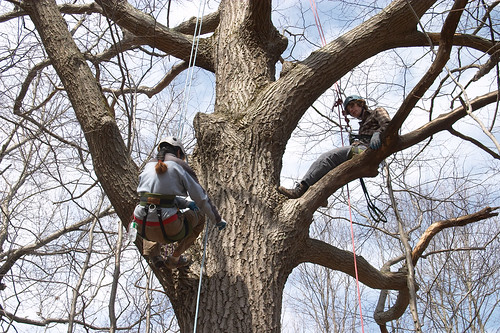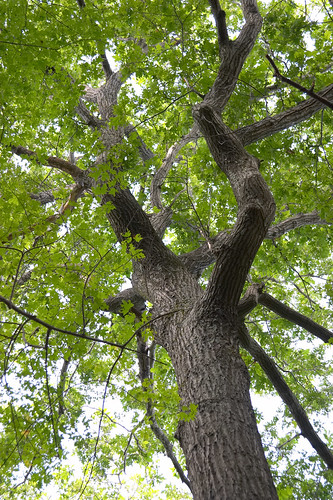- Posts: 1915
- Thank you received: 93
- Forums
- Tree Climbing Discussions
- Climbing Different Species of Trees
- Quercus rubra - Northern Red Oak
Quercus rubra - Northern Red Oak
- moss
-
 Topic Author
Topic Author
- Offline
- Platinum Boarder
-

Height (average to extreme): Tallest red oak in the east was measured in South Carolina in 2004, 152.9'. In the northeast an average mature forest tree is going to be in the 85-110 foot range.
Diameter (average to extreme): A good climbing tree can be anywhere from 35\" to 6' on the extreme end (usually an open grown tree)
Shape: The crown has an upright narrow vase shape. Forest grown trees will have a tall vertical column/bole
1st pitch height: (average to extreme): For forest trees 50-80 ft., open grown trees 25-50'.
Common hazards: Mature trees subject to heart rot. Rot can also start from the top of the bole down from wind broken leaders. Will hold dead limbs for extended periods of time, they can be very solidly attached or fall with a touch. Often grows in the forest with a codominant double or triple trunk right from the ground. I believe this is because multiple acorns sprout from bird and small mammal caches.
Notable features (why you like it): Smooth bark on the upper branches, doesn't snag throw bags like white oak. The mature trees can have a high magnificence factor with massive bole, limbs and an upper crown spreading out over the surrounding canopy. Interesting to climb with limbs attached to the bole at upward angles. Holds leaves late into the fall. A good solid tree, the bread and butter of hardwood climbing in the northeast.
Sound during breeze: rustling, clicking, upper branches clack like deer antlers in a hard gust.
Interesting information: Some arborists and climbers maintain that red oak will suddenly drop healthy limbs during a drought. I have never seen evidence of this happening. Assess as you would any hardwood, be cautious in your first climb on a new tree. Red oaks have been hit hard by drought conditions and the European Winter Moth which has devastated mature red oak in the last 3 years in eastern Massachusetts.
Climbing on a Northern Red Oak in early spring:
Crown of a forest grown red oak:
-moss
Please Log in or Create an account to join the conversation.
- markf12
-

- Offline
- Expert Boarder
-

- Posts: 112
- Thank you received: 0
In much of Minnesota and Wisconsin, northern red oak hybridizes freely with northern pin oak (Quercus ellipsoidalis).
Please Log in or Create an account to join the conversation.
- moss
-
 Topic Author
Topic Author
- Offline
- Platinum Boarder
-

- Posts: 1915
- Thank you received: 93
Around here, any tree that is big enough to climb can be pretty much guaranteed to have substantial heart rot - to the point where I have yet to find a tree I consider to be climbable. The flip side of this is that two of my favorite wild edible mushrooms, the sulphur shelf (Laetiporus sulphureus) and Hen of the Woods (Grifola frondosa) seem to be only found on northern red oaks around here. Both of these are heart-rot fungi.
The question becomes how much heart rot is too much. For our red oaks you can see by the overall state of the crown, the severely compromised trees have very ragged looking crowns. Some of these trees are so large that they can handle a certain amount of heart rot and have vigorous and healthy crown structure. Two very large red oaks that I've been looking at have Hen of the Woods growing out of the roots ten feet from the bole (in September), clearly attacking the tree but only a small part of the structural scenario for these trees because of the overall massiveness. If the fungus is right on the bole then look out. Definitely want to be inspecting and sounding the bole to assess. In our area pin oak tends to fall apart more readily than red oak in old age. A leaning old red oak is to be regarded with suspicion.
These are my observations of the red oaks that I've been climbing for nearly 3 years, I'm not an expert arborist.
-moss
Please Log in or Create an account to join the conversation.
- treeman
-

- Offline
- Platinum Boarder
-

- Posts: 710
- Thank you received: 21
Open cavities are often seen more in red oaks more so than the white oak family. A larger cavity opening increases risk. Multiple cavities in the same area is a worse sign.
I avoid rope settings far out on a red oak branches. It's the leverage factor I worry about if the branch has heart rot. Leaning leaders are second choices for the red oak family and vertical leaders favored because trees hold up much better to compression forces than shear forces found on far reaching branches.
Things I like: Wide open crotches. I don't see too many tight V formations which means the throw bag whizzes down and pulling up the climbing rope is much easier.
Northern red oak is much favored by wood workers than the southern red oak. It doesn't split and check while seasoning. But all the red oaks seem to have a strong odor when cut. Most folks describe it as dog poop smell. Not the kind of wood you want to stack in your basement.
Waving from a treetop,
Peter Treeman Jenkins
Please Log in or Create an account to join the conversation.
- 2chops
-

- Offline
- Gold Boarder
-

- Posts: 274
- Thank you received: 6
I recently did a red oak removal that was 24"dbh with an open cavity that was 40"high x 16"" wide. Plus it had a precarius lean to it over a nice lookin shed. I named this tree Gingavitis. I was tied in to a solid white ash behind it for safety sake. But, thankfully, the oak never made any kind of cracks or popping noises while I was up in it banging around. I was kinda surprised that it didn't do something unpleasant. But hey, that's OK.
It just goes to show how amazing trees can be in their strength. But as always, when going up for fun, best to err on the side of caution.
Ron.
Please Log in or Create an account to join the conversation.
- greenluck
-

- Visitor
-

Fairly fast growing......
Real nice tree for climbing......
Great for firewood with almost as many BTUs as Hickory and Locust.
Please Log in or Create an account to join the conversation.
- Forums
- Tree Climbing Discussions
- Climbing Different Species of Trees
- Quercus rubra - Northern Red Oak
Join Our Mailing List
Tree Climbers International, Inc.
1284 Merry Lane NE
Atlanta, GA
30329-3923
USA
Email us
Phone: 404-377-3150
Proud supporter of:

Website by 3by400, a north Georgia web design team using Joomla!

